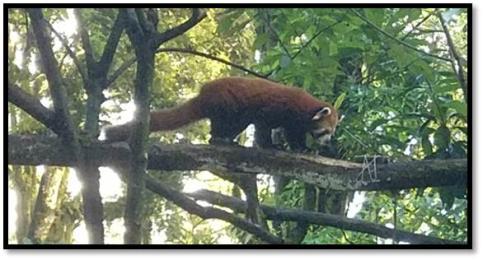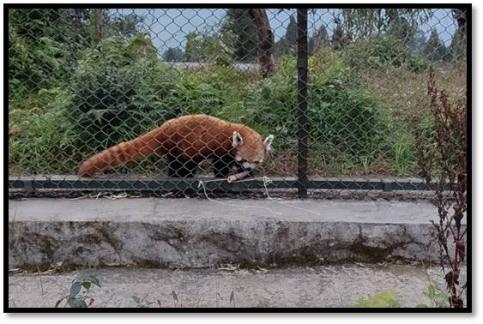Method
Facility

The biological sampling and data collection for this experiment were carried out in Padmaja Naidu Himalayan Zoological Park in the city of Darjeeling, West Bengal, India. The red pandas are housed in the New Conservation Breeding Center, Topkeydara, a facility situated approximately 20 km away from Darjeeling city. The 8 individual red pandas used in the study are housed as male-female pairs or mother and cubs in many enclosures. The Red Pandas in the breeding centers are not trained, tamed nor exposed to human contact except during feeding, transferring & research purposes. All the urine samples were collected from carnivores in the main zoo, which is situated approximately 2 km from Darjeeling city center.
Urine sample collection

The indoor enclosure of the animals were cleaned with antibacterial surface cleaners. The animals were let inside overnight. Urine collection took place at early mornings, as soon as it was witnessed that animal has urinated it was transferred to another enclosure as soon as possible. Foot covers, mouth and nose protection, gloves were used for protection before going inside the indoor enclosure. The urine was collected with a sterile syringe or a clean droppers and stored it in sterile plastic containers with a lid. The date, time and species of the collected sample were noted. The urine was stored in normal freezer within an 30 minutes of collection.
When using the urine sample, it was thawed by placing it next a warm source for few minutes (10-15 mins) until it was entirely liquid form. Droppers or sterile syringes were used to draw 3 drops (approx. 1mL) and drop it on clean pieces of filter paper. More than one piece of filter paper was impregnated and kept it in similar plastic containers used for storage of urine. The impregnated filter papers were stored at room temperature and used within 24hrs.
Trials

The filter paper (already impregnated with odour) was placed inside the bamboo and swiftly tied on the enrichment structure inside the enclosure. Camera were set up at a point where one can have clear view of the bamboo piece for at least 5 meters in radius and was left alone for an hour. Details of time, placement of odour presentation inside the enclosure, odour and individuals testing was noted during this time. The scheduling depended highly on daylight, weather conditions and activity pattern of animals. Whenever there was enough day light and weather conditions suitable for capturing useful footage the odours were presented. The presentation also depended on activity pattern of animal, this was random enough to incorporate break gaps to prevent habituation or spillover effect of previous odour presented. The video recordings were then analyzed using an ethogram describing 15 behaviours.
Responsible for this page:
Director of undergraduate studies Biology
Last updated:
05/24/19
